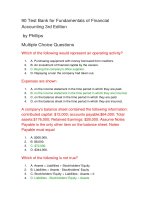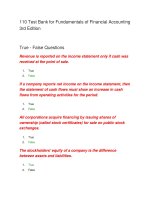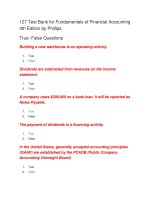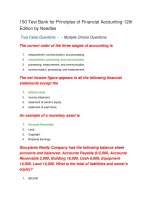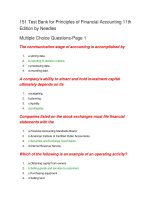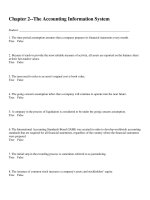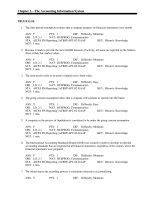Solution manual for cornerstones of financial accounting 3rd edition by rich jones mowen hansen
Bạn đang xem bản rút gọn của tài liệu. Xem và tải ngay bản đầy đủ của tài liệu tại đây (422.86 KB, 76 trang )
Solution Manual for Cornerstones of Financial Accounting
3rd edition by Rich Jones Mowen Hansen
Link full download solution manual: />Link full download test bank: />
2
THE ACCOUNTING
INFORMATION SYSTEM
DISCUSSION QUESTIONS
1.
The conceptual framework of accounting is the collection of general concepts that logically flow
from the objective of financial reporting—to provide information that is useful in making business
and economic decisions. The conceptual framework supports the development of generally
accepted accounting principles (GAAP) and provides a consistent body of thought for financial
reporting. An understanding of the conceptual framework will provide a logical structure to
financial accounting that will help in understanding complex accounting standards.
2.
The conceptual framework identifies two fundamental qualitative characteristics—relevance
and faithful representation. Relevant information is capable of making a difference in a
decision by helping users predict future events or providing feedback about prior
expectations. Relevant information is also material. Faithfully represented information
portrays the economic event it intends to portray. Faithfully represented information should be
complete (includes all necessary information for the user to understand the economic event),
neutral (unbiased), and free from error (as accurate as possible).
In addition to the fundamental qualitative characteristics, the FASB has identified four enhancing
characteristics—comparability, verifiability, timeliness, and understandability. Comparable
information allows external users to identify similarities and differences between two or more
items. Comparability includes consistency, which can be achieved by a company applying the
same accounting principles for the same items over time. Verifiable information describes a
situation in which independent parties can reach a consensus on the measurement of the
activity. Information is timely if it is available to users before it loses its ability to influence
decisions. Finally, if users who have a reasonable knowledge of accounting and business can,
with reasonable study effort, comprehend the meaning of the information, it is considered
understandable.
3.
Tradeoffs are often necessary between the qualitative characteristics. For example, the most
relevant information may not be able to be faithfully represented. Similarly, a change in
accounting principle may temporarily reduce comparability but improve the relevance of the
information. The goal should be to provide the most relevant information that can be faithfully
represented.
4.
Comparability refers to the ability to compare information across different companies or with
similar information about the same company for another time period. Consistency refers to the
use of the same accounting principles for the same items, either from one time period to another
time period within a company or in a single period across companies.
2-1
© 2014 Cengage Learning. All Rights Reserved. May not be scanned, copied or duplicated, or posted to a publicly accessible website, in whole or in
part.
5.
The cost constraint limits the ability of a company to provide useful information. The cost
constraint refers to the idea that some information that is useful would be too expensive for the
company to provide based on the benefit that is achieved from providing it.
6.
The four underlying accounting assumptions are the economic entity assumption, continuity
(going- concern) assumption, time-period assumption, and monetary unit assumption. The
economic entity assumption requires that a company be accounted for separately from its
owners. The continuity assumption assumes that a company will continue to operate long
enough to carry out its existing commitments. The time-period assumption allows the life of a
company to be divided into artificial time periods so net income can be measured for a specific
period of time. The monetary unit assumption requires that a company account for and report its
financial results in monetary terms.
2-2
© 2014 Cengage Learning. All Rights Reserved. May not be scanned, copied or duplicated, or posted to a publicly accessible website, in whole or in
part.
CHAPTER 2
The Accounting Information System
7.
There are four principles used to measure and record business transactions. First, the
historical cost principle requires transactions to be recorded at their cost—the exchange
price at the time the activity occurs. Second, the revenue recognition principle determines
when revenue is recorded and reported by a company. Under this principle, revenue must
be earned and the collection of cash must be reasonably assured in order to record and
report revenue. Third, the expense recognition (or matching) principle requires that an
expense be recorded and reported in the same period as the revenue it helped generate.
This may or may not be in the same period that cash is paid. Finally, the conservatism
principle states that accountants should take care to avoid overstating assets or income.
8.
The financial statements summarize the economic performance and status of a
business and are issued at least annually. Generally accepted accounting principles
(GAAP) are the rules and conventions that guide the preparation of financial statements.
GAAP provides a “common ground” that makes it easier to use financial statements
over time and across companies.
9.
Many events occur that affect the financial position and the operations of a business, but
only those that qualify for recognition as transactions are recorded in the accounting
records. To qualify as a transaction, the effect of the underlying events must impact a
financial statement element (asset, liability, stockholders’ equity, revenue, or expense)
and, thus,
the company’s financial statements. In addition, the event must be able to be faithfully
represented.
10.
Faithful representation refers to information faithfully representing the economic event that
it is intending to portray. Faithfully presented information should be complete, neutral, and
free from error. If information is not faithfully represented, it may mislead decision-makers.
These decision-makers would find it extremely difficult, if not impossible, to use
information that is incomplete or subject to significant error and/or bias.
11.
Transaction analysis usually begins with gathering the source documents that
describe business activities. Accountants must then analyze these documents to
determine which transactions should be recognized in the accounting system. If the
transaction is to be recorded in the accounting system, the transaction must then be
analyzed to determine
the effects it will have on the fundamental accounting equation. This analysis involves
three steps: (1) write down the accounting equation; (2) identify the financial statement
elements that are affected by the transaction; and (3) determine whether the element
increased or decreased.
12.
Yes, it is possible for a transaction to affect only one side of the accounting equation. While
the accounting equation must always remain in balance (meaning there must always be a
dual effect on the accounting equation), these effects can be on the same side of the
accounting equation. An example of this is when a customer pays cash for an accounts
receivable. Both cash and accounts receivable are asset accounts (on the left side of the
equation). One asset, accounts receivable, is decreasing, while another asset, cash, is
increasing by the same amount. This results in the accounting equation remaining in
balance, even though only one side of the equation was affected.
13.
When a firm earns revenue, its net income is increased. When a firm incurs an expense its
net income is decreased. At the end of the accounting period, net income is added to
retained earnings, a stockholders’ equity account. Therefore, an increase in revenue
increases stockholders’ equity and a decrease in revenue decreases stockholders’ equity.
Likewise, an increase in expense decreases stockholders’ equity and a decrease in
expense increases stockholders’ equity.
CHAPTER 2
The Accounting Information System
14. A T-account is a two-column record that consists of a title and two sides divided by a
vertical line. A T-account gets its name because it resembles the capital letter “T.” The
left side is referred to as the debit side, and the right side is referred to as the credit
side.
15. No, debit does not mean increase and credit does not mean decrease. The words debit
and credit simply refer to the left and right side of an account. Neither debit nor credit has
direct positive or negative connotations. Only when the terms debit and credit are associated
with a particular account can a debit or a credit be identified as an increase or a decrease.
For example, a debit increases an asset account but decreases a liability account.
16. To debit an account means to add an amount to the left side of that account. A debit
balance is a balance on the left side of an account. To credit an account means to add an
amount to the right side of that account. A credit balance is a balance on the right side of
an account. Debits and credits do not represent increases or decreases.
17. The normal balance of each of the accounts is:
(a) cash—debit
(b) sales—credit
(c) notes payable—credit
(d) inventory—debit
(e) retained earnings—credit
(f) salary expense—debit
(g) equipment—debit
(h) unearned revenue—credit
18. In each journal entry, the sum of the debits must equal the sum of the credits. If
transactions are recorded with debits equal to credits, then the equality of the accounting
equation will be maintained.
19. Accounting transactions are typically recorded initially in a journal on an event-by-event basis.
The recording of events in a journal allows the entire effect of a transaction to be
contained in one place. The individual effects of a transaction are then posted to the
general ledger. Potentially, a firm could put these transactions directly into the general
ledger. However, if the transaction were recorded directly into the general ledger, there
would be no evidence of the complete transaction in one place, which would make the
use of the information very cumbersome.
20. “Double-entry” is an appropriate description of an accounting system because each
transaction will affect at least two accounts and each transaction must have debit and credit
entries that must be equal.
21. The initial steps of the accounting cycle involve (1) analyzing transactions; (2) journalizing
transactions; (3) posting to the general ledger; and (4) preparing a trial balance. In the first
step, data is collected about business activities and analyzed to determine which activities
meet the criteria for recognition in the accounting records. If the data meet the recognition
criteria, the effect on the fundamental accounting equation is determined. In the second step,
the effects of the transaction on the fundamental accounting equation are recorded in the
accounting system using debits and credits. In the third step, journal entries are posted to the
general ledger, which is organized on an account-by-account basis. Finally, a trial balance is
prepared from account balances in the ledger.
22. Trial balances help detect errors resulting from inequality of debits and credits. A trial
balance usually will not help in the detection of omitted entries or errors of analysis,
journalizing, or posting when those errors cause incorrect account balances with equal
debits and credits.
CHAPTER 2
The Accounting Information System
MULTIPLE-CHOICE QUESTIONS
2-1.
c
2-2.
d
2-3.
c
2-4.
b
2-5.
a
2-6.
d
2-7.
c
2-8.
a
2-9.
d
2-10.
a
2-11.
c
2-12.
a
2-13.
d
2-14.
a
2-15.
b
CHAPTER 2
The Accounting Information System
CORNERSTONE EXERCISES
CE 2-16
a. Faithful representation
b. Consistency
c. Materiality
CE 2-17
a. Cost vs. benefit
b. Relevance
c. Comparability
CE 2-18
a. Monetary unit
b. Continuity (going-concern)
c. Economic entity
d. Time period
CE 2-19
a. Revenue recognition
b. Conservatism
c. Historical cost
d. Matching
CE 2-20
a.
b.
c.
d.
Assets
Liabilities
Stockholders’
Equity
+
+/–
+
–
NE
NE
+
NE
+
NE
NE
–
CHAPTER 2
The Accounting Information System
CE 2-21
=
Liabilities
+
Assets
a.
b.
c.
d.
30,000
10,000
3,000
(3,000)
Stockholders’ Equity
Contributed
Retained
Capital
+ Earnings
30,000
10,000
3,000
(3,000)
CE 2-22
a.
b.
c.
d.
Assets
21,500
9,500
(9,500)
(500)
(4,000)
=
Liabilities
CE 2-23
a.
b.
c.
d.
e.
f.
g.
h.
Account
Accounts Payable
Accounts Receivable
Retained Earnings
Sales
Equipment
Common Stock
Salary Expense
Repair Expense
+
Stockholders’ Equity
Contributed
Retained
Capital
+
Earnings
21,500
(500)
(4,000)
Normal
Balance
Credit
Debit
Credit
Credit
Debit
Credit
Debit
Debit
Debit
Decrease
Increase
Decrease
Decrease
Increase
Decrease
Increase
Increase
Credit
Increase
Decrease
Increase
Increase
Decrease
Increase
Decrease
Decrease
CHAPTER 2
CE 2-24
The Accounting Information System
Journal
Date
June
Account and Explanation
1 Cash
Common Stock
(Record issuance of common stock)
8 Equipment
Cash
(Record purchase of equipment)
15 Cash
Sales Revenue
(Record cash sale)
Date
May
Credit
100,000
16,800
16,800
23,200
23,200
29 Dividends
Cash
(Declared and paid cash dividends)
CE 2-25
Debit
100,000
4,500
4,500
Journal
Account and Explanation
5 Cash
Notes Payable
(Record borrowing of cash from bank)
Debit
40,000
Credit
40,000
10 Cash
Sales Revenue
(Record cash sale)
28,500
19 Salaries Expense
Cash
(Record payment of salaries)
15,600
28,500
15,600
22 Supplies
Cash
(Record purchase of supplies)
7,100
22 Supplies Expense
Supplies
(Record use of supplies)
7,100
7,100
7,100
CHAPTER 2
The Accounting Information System
CE 2-26
Cash………………………………………………………………
Borges Inc. Trial Balance
December 31, 2013
Accounts Receivable…………………………………………
Equipment………………………………………………………
Accounts Payable………………………………………………
Account
Common Stock…………………………………………………
Dividends…………………………………………………………
Service Revenue………………………………………………
Rent Expense……………………………………………………
Salaries Expense………………………………………………
Advertising Expense …………………………………………
$12,850
5,700
12,725
Debit
$ 2,825
Credit
15,000
1,500
23,150
2,400
4,300
1,500
$40,975
$40,975
CHAPTER 2
The Accounting Information System
BRIEF EXERCISES
BE 2-27
a.
Relevance; faithful representation
b.
Comparability
c.
Understandability
d.
Faithful representation
e.
Verifiable
f.
Timeliness
BE 2-28
a.
Revenue recognition principle
b.
Economic entity assumption
c.
Historical cost principle
d.
Expense recognition (or matching) principle
e.
Time period assumption
BE 2-29
a.
Yes, the event qualifies for recognition.
b.
Yes, the event qualifies for recognition.
c.
Yes, the event qualifies for recognition.
d.
No. the event does not qualify for recognition because no financial statement
element will be affected until at least one party to the contract performs its
responsibility (the service is performed or money is actually exchanged).
BE 2-30
a.
b.
c.
d.
e.
f.
Assets
50,000
25,000
(25,000)
(500)
10,000
3,000
(3,000)
(2,500)
Stockholders' Equity
= Liabilities + Contributed Capital
+ Retained Earnings
50,000
(500)
10,000
(2,500)
CHAPTER 2
The Accounting Information System
BE 2-31
Account
a. Accounts Receivable
b. Accounts Payable
c. Cash
d. Equipment
e. Notes Payable
f. Rent Expense
g. Salaries Expense
h. Service Revenue
Normal Balance
Debit
Credit
Debit
Debit
Credit
Debit
Debit
Credit
Debit
Increase
Decrease
Increase
Increase
Decrease
Increase
Increase
Decrease
Credit
Decrease
Increase
Decrease
Decrease
Increase
Decrease
Decrease
Increase
BE 2-32
Date
Jan.
Journal
Account and Explanation
1 Cash
Notes Payable
(Record issuance of note payable)
4 Equipment
Cash
(Record purchase of equipment)
6 Rent Expense
Cash
(Record payment of rent)
Debit
50,000
Credit
50,000
25,000
25,000
500
500
15 Accounts Receivable
Service Revenue
(Record performance of services)
10,000
25 Cash
Accounts Receivable
(Record collection from customer)
3,000
30 Salaries Expense
Cash
(Record payment of salaries)
2,500
10,000
3,000
2,500
CHAPTER 2
The Accounting Information System
BE 2-33
Cash
Beg. Bal.
Jan. 1
Beg. Bal.
12,000
50,000
25,000
500
Jan. 25
Equipment
Beg. Bal.
Jan. 4
End. Bal.
Jan. 15
10,000
3,000
3,000
2,500
End. Bal.
Jan. 4
Jan. 6
Accounts Receivable
6,300
Jan. 25
Jan. 30
37,000
End. Bal.
13,300
Notes Payable
5,000
25,000
30,000
0
50,000
50,000
Service Revenue
19,500
10,000
29,500
Rent Expense
Beg. Bal.
Jan. 6
End. Bal.
Beg. Bal.
Jan. 15
End. Bal.
Beg. Bal.
Jan. 30
End. Bal.
Beg. Bal.
Jan. 1
End. Bal.
Salary Expense
5,000
2,500
7,500
1,000
500
1,500
BE 2-34
Mason Company
Trial Balance
December 31, 2013
Account
Cash……………………………………………………
Accounts Receivable………………………………
Supplies………………………………………………
Prepaid Insurance……………………………………
Accounts Payable……………………………………
Salaries Payable………………………………………
Unearned Service Revenue…………………………
Notes Payable…………………………………………
Common Stock………………………………………
Dividends………………………………………………
Retained Earnings……………………………………
Service Revenue……………………………………
Insurance Expense…………………………………
Salaries Expense……………………………………
Supplies Expense……………………………………
Debit
$20,000
10,300
1,200
1,900
Credit
$ 3,000
1,900
2,100
3,100
10,000
2,000
8,000
19,200
1,500
9,500
900
$47,300
$47,300
CHAPTER 2
The Accounting Information System
EXERCISES
E 2-35
1.
a. Timeliness
b. Verifiability
c. Understandability
d. Relevance
2.
e.
f.
g.
h.
Relevance
Faithful representation
Comparability
Faithful representation
The conceptual framework flows logically from the fundamental objective of
financial reporting—to provide information that is useful for making investment
and credit decisions—and its purpose is to support the development of a
consistent set of accounting standards and provide a consistent body of
thought for financial reporting. The conceptual framework provides a logical
structure to financial accounting and helps to explain “why” accountants adopt
certain practices.
E 2-36
1. e.
2. a.
3. d.
4. f.
Historical cost
Economic entity
Monetary unit
Revenue recognition
5.
6.
7.
8.
b.
c.
h.
g.
Continuity (going-concern)
Time-period
Conservatism
Expense recognition (matching)
E 2-37
1. and 2.
a. Yes, the event qualifies for recognition.
b.
No, the agreement does not qualify for recognition because no financial
statement element will be affected until at least one party to the contract
performs its responsibility (the service is performed or money is actually
exchanged).
c.
Yes, the event qualifies for recognition.
d.
Yes, the event qualifies for recognition.
e.
No, this transaction does not qualify for recognition in the financial statements
of the company because it does not affect the overall common stock of the
company. This transaction is between two entities (the individual investors) that
are separate from the company.
f.
Yes, the event qualifies for recognition.
CHAPTER 2
The Accounting Information System
E 2-38
1. and 2.
a. Qualify.
b.
Does not qualify. The accounting equation has not been affected by ordering
the product. When the cash register is delivered or paid for, one of the parties
to the contract will have performed, and the transaction will qualify for recording.
c.
Qualify.
d.
Does not qualify. It has to do with the owner’s personal transactions, not the
company’s transactions.
e.
Does not qualify. The extension does not affect the accounting equation. Once
one of the parties performs according to the contract (the store is occupied in
April 2013 or rent is paid), the transaction will be recorded.
f.
Qualify.
g.
Qualify.
E 2-39
1. a.
2.
Increase assets (cash) $3,200 and increase stockholders’ equity (revenue)
$3,200.
b.
Increase assets (accounts receivable) $1,700 and increase stockholders’
equity (revenue) $1,700.
c.
Increase assets (land) $30,000 and decrease assets (cash) $30,000.
d.
Increase assets (supplies) $900 and increase liabilities (accounts payable)
$900.
e.
Decrease assets (cash) $2,500 and decrease stockholders’ equity
(dividend) $2,500.
f.
Decrease assets (cash) $550 and decrease liabilities (accounts payable)
$550.
g.
Decrease assets (cash) $800 and decrease stockholders’ equity (expense)
$800.
h.
Increase assets (cash) $1,500 and decrease assets (accounts receivable)
$1,500.
i.
Increase assets (cash) $20,000 and increase stockholders’ equity (common
stock) $20,000.
For Transaction d, supplies were recorded as an asset at their historical cost—
the exchange price of the transaction. Later, as the supplies are used, the
matching principle will guide the amount of supplies that will be expensed. This
application of the matching concept will be discussed more fully in Chapter 3.
CHAPTER 2
The Accounting Information System
E 2-40
Stockholders’ Equity
Assets
a.
b.
c.
d.
e.
f.
g.
h.
i.
j.
k.
=
30,000
(18,500)
18,500
2,750
(2,750)
(800)
3,910
(1,100)
(650)
(1,900)
1,050
(600)
Liabilities
+
b.
c.
d.
e.
f.
2.
a.
b.
c.
d.
e.
f.
+
Retained
Earnings
30,000
2,750
(2,750)
(800)
3,910
(1,100)
(650)
(1,900)
1,050
(600)
E 2-41
1.
a.
Contributed
Capital
Stockholders’ Equity
Assets
875,000
(875,000)
125,000
86,000
10,400
(10,400)
(36,250)
(5,000)
Investing
Financing
Investing
Operating
Operating
Financing
=
Liabilities
+
Contributed
Capital
+
Retained
Earnings
125,000
86,000
(36,250)
(5,000)
CHAPTER 2
E 2-42
a.
The Accounting Information System
This transaction is a result of purchasing land for cash.
b.
This transaction is a result of paying cash for an expense (e.g., rent
expense) or a result of paying cash for dividends.
c.
This transaction is a result of issuing common stock in exchange for
cash.
d.
This transaction is a result of borrowing cash.
E 2-43
Stockholders’ Equity
Assets
a.
b.
c.
d.
e.
f.
g.
h.
i.
j.
k.
=
Liabilities
+
Contributed
Capital
+
Retained
Earnings
75,000
75,000
35,000
(12,000)
12,000
(7,800)
7,800
6,300
18,750
(9,500)
(10,200)
10,200
1,800
(1,200)
(1,800)
35,000
6,300
18,750
(9,500)
1,800
(1,200)
(1,800)
E 2-44
Stockholders’ Equity
Assets
a.
b.
c.
d.
e.
12,000
1,100
36,500
(5,500)
3,200
(300)
=
Liabilities
+
Contributed
Capital
+
Retained
Earnings
12,000
1,100
31,000
3,200
(300)
CHAPTER 2
The Accounting Information System
E 2-45
a. This transaction is the result of purchasing equipment for cash.
b.
This transaction is the result of performing services (generating revenue) in
exchange for cash.
c.
This transaction is the result of purchasing supplies on account (on credit).
d.
This transaction is the result of the use of supplies.
E 2-46
Account
Accounts Payable
Accounts Receivable
Accumulated Depreciation (Equipment)
Advertising Expense
Cash
Common Stock
Cost of Goods Sold
Depreciation Expense (Equipment)
Equipment
Interest Expense
Inventory
Notes Payable
Retained Earnings
Sales Revenue
Utilities Expense
Debit
Credit
X
X
X
X
X
X
X
X
X
X
X
X
X
X
X
Financial
Statement
Balance sheet
Balance sheet
Balance sheet
Income statement
Balance sheet
Balance sheet
Income statement
Income statement
Balance sheet
Income statement
Balance sheet
Balance sheet
Balance sheet, retained
earnings statement
Income statement
Income statement
CHAPTER 2
The Accounting Information System
E 2-47
a.
Assets
Increase
(Debit)
=
Liabilities
Increase
(Credit)
+
Stockholders’ Equity
Contributed
Retained
+
Capital
Earnings
b.
Increase
(Debit)
c.
Decrease
(Credit)
d.
Increase
(Debit)
e.
Decrease
(Credit)
Decrease
(Debit)
f.
Increase
(Debit)
Increase
(Credit)
g.
Increase
(Debit)
Increase
(Credit)
h.
Increase
(Debit)
i.
Decrease
(Credit)
j.
Increase/Decrease
(Debit)/(Credit)
k.
Decrease
(Credit)
Increase
(Credit)
Decrease
(Debit)
Increase
(Credit)
Increase
(Credit)
Decrease
(Debit)
Decrease
(Debit)
CHAPTER 2
The Accounting Information System
E 2-48
Transaction
Account
Increase/
Decrease
Debit/
Credit
Amount
a.
b.
c.
d.
e.
f.
g.
h.
i.
j.
Land
Cash
Equipment
Notes Payable
Supplies
Accounts Payable
Notes Payable
Interest Expense
Cash
Accounts Payable
Cash
Accounts Receivable
Service Revenue
Cash
Service Revenue
Cash
Accounts Receivable
Wages Expense
Cash
Cash
Common Stock
Increase
Decrease
Increase
Increase
Increase
Increase
Decrease
Increase
Decrease
Decrease
Decrease
Increase
Increase
Increase
Increase
Increase
Decrease
Increase
Decrease
Increase
Increase
Debit
Credit
Debit
Credit
Debit
Credit
Debit
Debit
Credit
Debit
Credit
Debit
Credit
Debit
Credit
Debit
Credit
Debit
Credit
Debit
Credit
$35,200
$35,200
$16,400
$16,400
$1,500
$1,500
$15,000
$600
$15,600
$3,150
$3,150
$65,300
$65,300
$15,400
$15,400
$32,800
$32,800
$10,300
$10,300
$40,000
$40,000
CHAPTER 2
The Accounting Information System
E 2-49
Journal
Date
Account and Explanation
Mar.
2 Cash
Service Revenue
(Record revenue)
Debit
51,500
51,500
3 Inventory
Accounts Payable
(Record purchase of surfboards)
1,800
6 Wages Expense
Cash
(Record wages)
9,200
9 Rent Expense
Cash
(Record rent)
1,000
12Trucks
Cash
Notes Payable
(Record purchase of truck)
13Cash
Accounts Receivable
(Record collection of customer account)
16Accounts Payable
Cash
(Record payment of account owed)
23Cash
Notes Payable
(Record borrowing of cash)
27Utilities Expense
Cash
(Record payment of telephone bill)
30Advertising Expense
Cash
(Record payment for advertising)
Credit
1,800
9,200
1,000
40,800
1,000
39,800
1,050
1,050
950
950
10,000
10,000
185
185
1,550
1,550
CHAPTER 2
The Accounting Information System
E 2-50
1.
Journal
Date
Account and Explanation
Nov.
2 Cash
Service Revenue
(Record revenue earned)
6 Supplies
Accounts Payable
(Record purchase of supplies on account)
Dec.
2.
Debit
2,400
Credit
2,400
4,750
4,750
10Wages Expense
Cash
(Record payment of wages)
5,250
15Accounts Payable
Cash
(Record payment on account)
4,750
28Utilties Expense
Cash
(Record use of utilities)
2,150
30Repairs & Maintenance Expense
Accounts Payable
(Record repairs performed on account)
1,230
10Accounts Payable
Cash
(To record payment of account)
1,230
5,250
4,750
2,150
1,230
1,230
The recording of the November 10 transaction was based on the matching
principle. Remington’s workers helped to produce revenue in November.
Therefore, the wages expense that was part of Remington’s normal operations
needs to be recorded in the same period as the revenue.
CHAPTER 2
The Accounting Information System
E 2-51
Journal
Date
Account and Explanation
Jan.
14Cash
Common Stock
(Record issuance of common stock)
Feb.
Mar.
May
June
Debit
80,000
80,000
14Cash
Notes Payable
(Record borrowing of cash)
45,000
22Land
Buildings
Cash
Notes Payable
(Record purchase of land and building)
30,000
60,000
1 Buildings
Cash
(Record payment for remodeling)
3 Buildings
Accounts Payable
(Record amount due for remodeling)
Credit
45,000
34,000
56,000
4,000
4,000
11,000
11,000
20Accounts Payable
Cash
(Record payment on account)
11,000
4 Supplies
Cash
(Record purchase of supplies)
650
11,000
650

